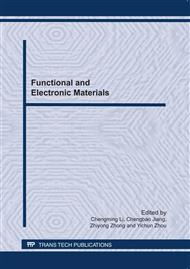p.750
p.756
p.759
p.765
p.771
p.778
p.784
p.791
p.798
Transparency of Hybrid Films Based on (γ-Methacrylpropyl)- Trimethoxysilane and its Validation by Computing Energy-Band Structure
Abstract:
Using (γ-methacrylpropyl)-trimethoxysilane (MPMS) modified with various amounts of tetraethoxysilane (TEOS) and titanium tetrabutoxide (TTB), two kinds of hybrid films, film-MPMS-silsesquioxane (SSO)-TEOS (f-MSTE) and film-MPMS-SSO-TTB (f-MSTT), were prepared. The average transparency (AT) of the modified films, about 90-94%, was measured in the ranges of the VIS light region (400-750 nm) and in the NIR region (750-2500 nm), indicating that these high-AT films can provide crops with growth energy and improvement of the photosynthetic process efficiency. Both TEOS and TTB adequate additions resulted in a hybrid structure (containing SiO2 and TiO2), and an addition can cause an increase in the AT radiation from sunlight. However, the AT of f-MSTE is higher than that of f-MSTT, which was validated using molecular dynamic simulation and calculation of the states density and the energy-band structure of MPMS-SSO, SiO2 and TiO2 building blocks.
Info:
Periodical:
Pages:
778-783
Citation:
Online since:
June 2011
Authors:
Keywords:
Price:
Сopyright:
© 2011 Trans Tech Publications Ltd. All Rights Reserved
Share:
Citation:


